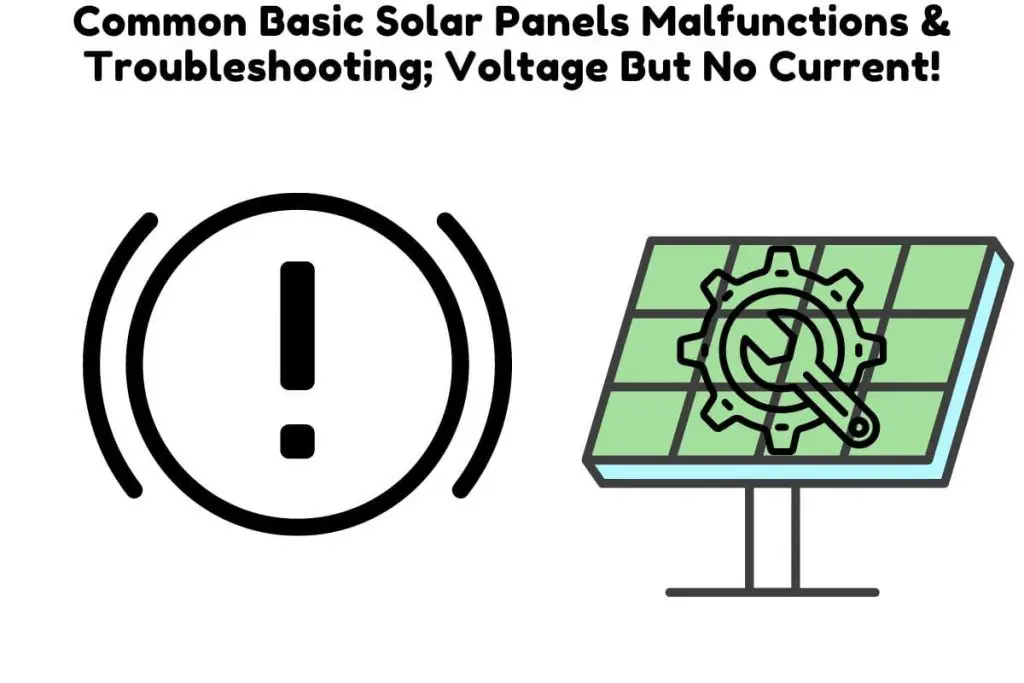The average residential solar system in the U.S is sized at 5 kilowatts. That means it produces around 5000 watts of current. Typically, this is enough to provide for the needs of most households. But what happens if solar panels stop working?
In this article, we will walk you through some of the basic problems a solar panel can experience. Specifically, we will look at the more common problems relating to solar panel output. For example, why would a solar panel produce low or no current?

Do Solar Panels Produce Voltage Or Current?
Electronic circuits require both voltage and current to produce energy. Solar panels produce power which means they too have voltage and current. The equation for working out power, measured in watts or amps, in a solar panel is volts multiplied by current.
The relationship between voltage and current is a foundation of electronics that is important for designing a solar panel system. But first what do voltage and current do in the first place?
On a side note! If you’re in need of a reliable and high-performance portable solar panel, We strongly recommend the Jackery SolarSaga 100W Portable Solar Panel (Amazon Link).
With a high conversion efficiency and foldable design, this solar panel is easy to transport and set up, making it perfect for outdoor activities like camping, hiking, and RV trips.

The US solar cell technology used in this panel ensures that you get the most efficient and reliable solar charging possible.
There is also a 60W option that is more affordable (Amazon Link)
The function of voltage
Voltage is the electromotive force that makes current happen in a solar panel. When you open a tap, the pressure causes the flow of water. The same concept applies in electronics except here the pressure is voltage.
Voltage pushes current from a solar panel to either a battery or inverter or directly to an appliance. Voltage is measured in volts with the standard notation being (V).
The function of current
Current is the charge or flow of electrons through a circuit that results in work being done. Current is a rate at which electrons move. Think of it as the rate at which cars move on a highway with each car being an electron. To measure current, you take how many cars pass a given point over some time, typically an hour. Source
The simplest model of a circuit producing work is connecting a small solar panel to a light bulb. Current is represented by the symbol (I) and is measured in amps.
Putting volts and current together
Solar panels have an IV curve which describes the relationship between voltage and current. The IV curve is an important element of solar system design. It is used to graphically represent the performance of a solar panel under certain conditions.
The IV curve gives you five important characteristics you need to take into consideration when designing a solar system. These are:
- Maximum Power Point (Mpp) is the highest power output of the solar panel. This is the voltage multiplied by the current.
- Open Circuit Voltage (Voc) is the maximum voltage of the solar panel when the current is at zero.
- Short Circuit Current (Isc) is the maximum current of the solar panel when the voltage is zero.
- Maximum Power Voltage (Vmp) is the maximum voltage when there is a current.
- Maximum Power Current (Imp) is the maximum current with a voltage.
All these values are given on the back of a solar panel. They are, however, under lab conditions and not used as is. Instead, the standard practice is to test the solar panel to get accurate values that are then used to design a solar system. Source
While it’s a given that for a solar panel to produce energy there must be both volts and current, it can happen that one is missing.
Why Do I Have Voltage But No Amps?
Having voltage but no current in a solar panel is frequently caused by an open circuit. It may also be caused by errors elsewhere in the system such as the charge controller or inverter. Finally, it could be the result of a defective solar panel.
Open circuit errors
An open circuit is an incomplete or improperly wired circuit. A common cause of circuit errors is using incorrect voltages.
For current to flow there should be a difference between the source and the destination voltage. Current flows from high voltage to low voltage. For example, if a solar panel has a voltage of 5.5V and a battery is 12V, current will not flow from the solar panel to the battery.
Charge controller error
The problem can also be caused by a faulty charge controller. A charge controller controls the flow of current into a battery. If there is no current coming from the charge controller it could simply mean there is a problem with the controller. The best way to check whether the problem is with the charge controller is to check the short circuit current of the solar panels.
Solar panel error
A third factor that could cause there to be no current is a malfunctioning solar panel. A solar panel may have faulty connectors or junction box. Again, you need to check the solar panels’ short circuit current and do a physical inspection of the solar panels.
How Do You Test If A Solar Panel Is Working?
The simplest way to determine if a solar panel is working is to check the inverter or charge controller. Either of those should indicate whether the solar panel is producing any current. They should give a reading of both the voltage and current produced.
An alternative but a slightly more complicated way to test if a solar panel is working is to test the solar panel current.
How Do You Test A Solar Panel Current?
A multimeter is used to test the short circuit current of a solar panel. This is a preliminary step taken when designing a solar panel system because it gives the real-world output of the solar panel.
Using a multimeter here are the steps you would take to measure the solar panel current:
- Set the multimeter to read amps.
- Connect the positive to negative leads of the solar panel.
- Position the solar panel in the sun.
- Pass the clamps of the multimeter through the connection to get the reading.
Why Is Solar Panel Current Low?
Low current in a solar panel is frequently caused by shading. The more shade the less current a solar panel will produce. Other factors that can lead to low output are temperature, defective solar panels, and bad connections.
Checking the location of your solar panels should be the first step in troubleshooting what could be causing low or no current. This is because shading is very often the reason why solar panels are not performing as they should.
Although this affects them to a very small degree, extreme heat will also reduce the current in a solar panel. Unless you live in extremely hot areas that reach over 45 degrees Celsius, however, you don’t have to worry about heat being a factor.
